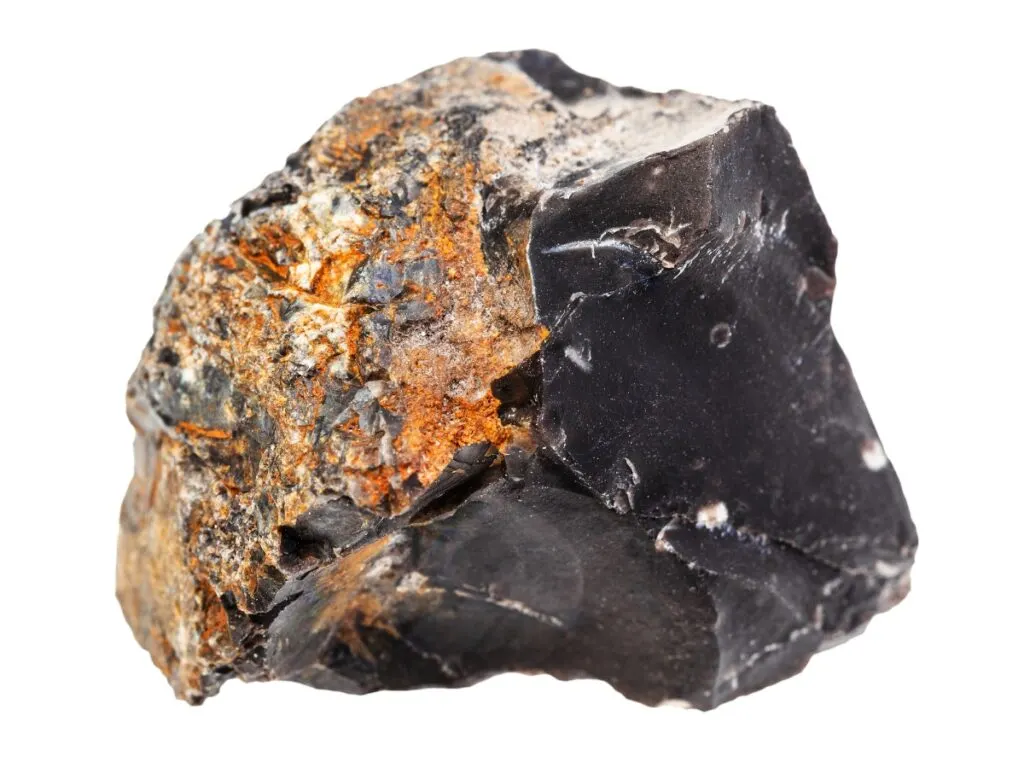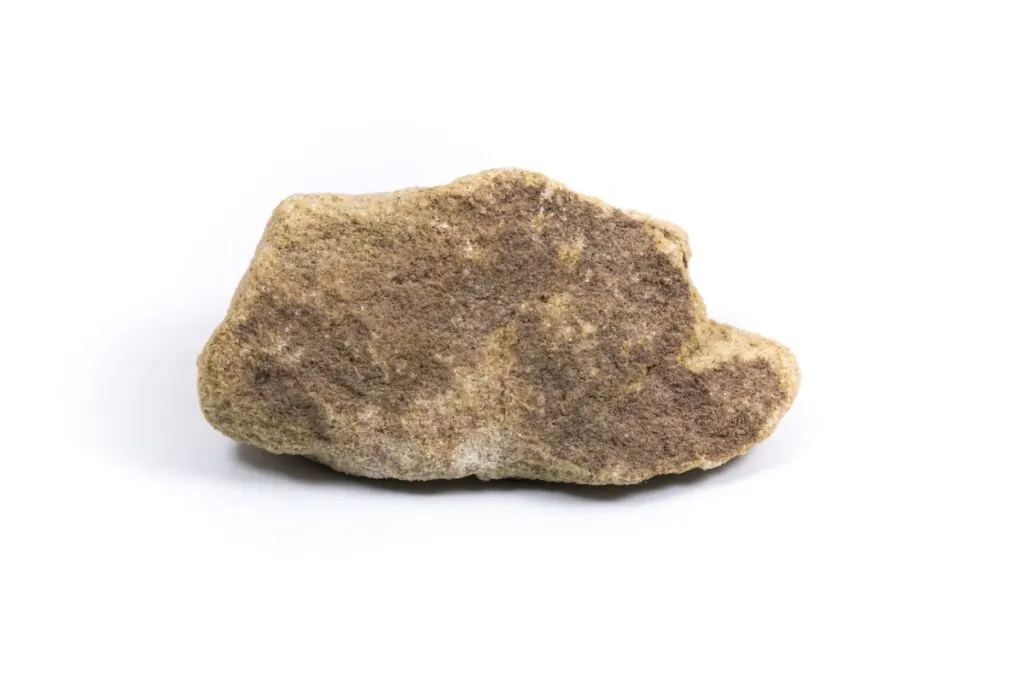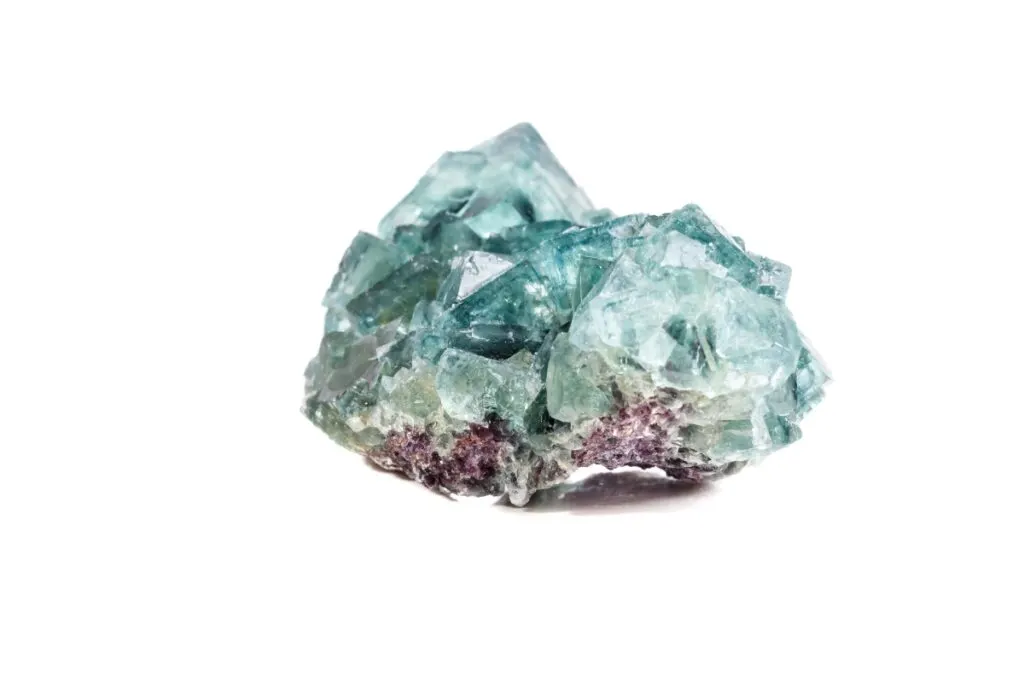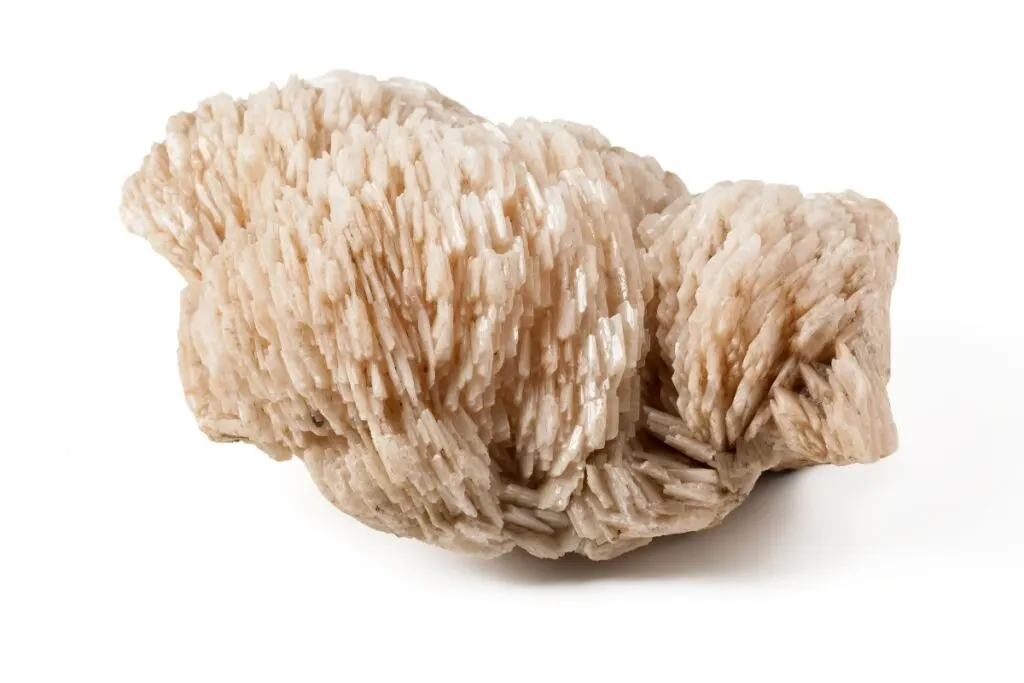As an Amazon Associate, I earn from qualifying purchases with no additional costs for you.
The Bluegrass State of Kentucky is famous for many things, including horseback racing, bluegrass music, and even rocks such as coal and limestone. There are more than enough rocks and minerals to catch a rockhound’s interest in the Bluegrass State, as you’ll find out in this guide to the 15 common rocks and minerals of Kentucky.
Deep down underneath the bluegrass fields and plains of Kentucky, rockhounds can find:
- geodes,
- flint,
- agate,
- peridotite,
- bituminous coal,
- limestone,
- sandstone,
- fluorite,
- pyromorphite,
- celestine,
- galena,
- calcite,
- barite,
- hemimorphite,
- and chalcedony.
Just as every treasure hunter needs a map, every rockhound needs information before searching for rocks and minerals. This guide to Kansas’ common rocks and minerals will lead you to the best treasures for your collection.

If you are interested in checking out the best rockhounding tools you can find them by clicking here (Amazon link).
What Rocks Are Found in Kentucky
Coal, limestone, and geodes are just a few of the rocks you can find in Kentucky, among others, such as:
Geodes

| Location | GPS Coordinates |
|---|---|
| Mount Vernon | 37.370682, -84.364004 |
| Kentucky Lake | 36.531314, -88.054954 |
| Green River | 37.219468, -86.382152 |
| Lyon County | 37.041956, -88.061443 |
| Lincoln County | 37.469214, -84.567606 |
| Adair County | 37.198994, -85.258332 |
| Warsaw Formation | 36.705498, -85.706292 |
Kentucky is a state that’s rich in geodes, and you can find these gorgeous rocks in all shapes and sizes. The most common crystals that you’ll find inside Kentucky geodes are quartz and calcite.
Although the most common quartz and calcite color is transparent, some rockhounds do find smokey quartz and darker calcites within these geodes.
Rockhounds usually find that geode hunting in Kentucky is a breeze, especially when they search near Mount Vernon, Kentucky Lake, or the Green River. Some Kentucky counties that are known for their geodes are Lyon County, Lincoln County, and Adair County.
Flint

| Location | GPS Coordinates |
|---|---|
| Carter County | 38.302399, -83.083364 |
| Harlan County | 36.893427, -83.075941 |
| Trigg County | 36.840645, -87.963480 |
| Flint Ridge | 37.197415, -86.073672 |
| Hardin County | 37.724180, -85.847776 |
| Barren County | 36.904436, -86.047109 |
If you’re on the hunt for flint, you have a great variety to choose from in Kentucky. Some popular types of flint and chert that you can seek out in this state include:
- Sonora Flint,
- Flint Ridge Chert,
- Nethers Chert,
- Boyle Chert,
- Haney Chert,
- and Paoli Chert.
Kentucky flint comes in plenty of colors, such as green, blue, black, and tan, and the quality varies depending on the location.
In addition to the fan-favorite location of Fling Ridge, you can also find high-quality flint in Carter County, Trigg County, and Hardin County.
Recommendation box: All tools and equipment you need for rockhounding and rock identification* (Amazon links):
1. Estwing Rock Hammer – Light, comfortable, and extremely durable hammer.
2. Estwing Geologist Pick – Classic and the most trusted paleo pick in the world.
3. Finder 12-inch Chisels – Heavy-duty chisels set with hand protection.
4. Mini Handle Shovel – This is a great tool for digging deep in the dirt.
5 Ironclad Utility Work Gloves – Breathable, but they also protect the areas requiring them most.
6. 3M Safety Glasses – Comfortable and efficient goggles for rockhounding.
7. Convoy 8+ UV Light – 365nm UV LED flashlight with a patented glass filter.
8. Wesley’s Jewelers Loupe – High magnification options (30X and 60X) with carrying case.
9. Mohs Hardness Kit – A specially designed kit for rockhounds
*All recommended products are personally tested and regularly used by experts from this website.
Agate

| Location | GPS Coordinates |
|---|---|
| Graves County | 36.760214, -88.624396 |
| Eddyville | 37.069116, -88.095754 |
| Lyon County | 36.980547, -88.021617 |
| Estill County | 37.720119, -83.990920 |
| Jackson County | 37.434412, -83.990197 |
| Rockcastle County | 37.370800, -84.365470 |
| Lee County | 37.568127, -83.730078 |
Since Kentucky’s state rock is agate, it’s no surprise that rockhounds find them everywhere. Banded agates with red, black, yellow, and gray colors are abundant in almost every area of the state, so rockhounds have no trouble finding them.
To find agate in Kentucky, check out Graves County, Lyon County, Estill County, and Jackson County. The rivers and creeks of these counties are known for their wealth of high-quality agates!
Peridotite

| Location | GPS Coordinates |
|---|---|
| Elliot County | 38.126969, -83.089805 |
| Ison Creek | 38.125279, -82.998707 |
| Crittenden County | 37.427112, -88.281299 |
| Caldwell County | 37.115155, -87.709400 |
| Livingston County | 37.233419, -88.451528 |
| Brushy Creek | 38.162932, -82.987325 |
Peridotite is a coarse, dark-green igneous rock that’s mainly composed of the mineral olivine, which is peridot that’s not gem quality. A rare variant of peridotite that’s found in Elliot County is kimberlite, a rock that’s known for containing diamonds.
Although Elliot County is famous for its peridotite, the surrounding counties of Caldwell and Livingston are also excellent sites for this rock.
TIP: If you want to find olivine mineral specimens, especially the peridot gemstone variant in the U.S., you need to understand how it forms. Find out more in the article below:
Where to Find Olivine: Best Environments & Locations (USA)
Bituminous Coal

| Location | GPS Coordinates |
|---|---|
| Floyd County | 37.558784, -82.755512 |
| Harlan County | 36.893427, -83.075941 |
| Lawrence County | 38.077814, -82.720711 |
| Livingston County | 37.215923, -88.435735 |
| Clay County | 37.210547, -83.717442 |
| Marshall County | 36.895239, -88.295536 |
| Bell County | 36.692576, -83.745458 |
Bituminous coal is one of the most important resources that Kentucky provides, and it’s primarily found in two regions, known as the Eastern Kentucky Coal Field and the Western Kentucky Coal Field.
Bituminous coal is a black rock that has many important uses, such as producing electricity, heat, steel, and iron. Interestingly, even though coal is a sedimentary rock, it has officially claimed the title of Kentucky’s state mineral!
There are 57 counties in Kentucky that produce coal, and some of the best ones to visit are Floyd County and Harlan County.
Limestone

| Location | GPS Coordinates |
|---|---|
| Warren County | 37.012399, -86.427645 |
| Livingston County | 37.171071, -88.412389 |
| Meade County | 38.047879, -86.277390 |
| Christian County | 36.903255, -87.501913 |
| Lexington | 38.001166, -84.454411 |
| Warsaw | 38.781271, -84.909071 |
Did you know that more than 50 percent of Kentucky’s surface rocks are limestones? Most of the limestones in Kentucky contain fossilized sea creatures from the shallow sea that covered the state millions of years ago.
No matter where you go in Kentucky, there’s sure to be limestone nearby. Check out Warren County, Livingston County, and Meade County for this sedimentary rock.
Sandstone

| Location | GPS Coordinates |
|---|---|
| Breckenridge County | 37.813710, -86.490160 |
| Livingston County | 37.114146, -88.409643 |
| Carter County | 38.300782, -83.127309 |
| Grayson County | 37.455603, -86.282055 |
| Metcalfe County | 36.983117, -85.591518 |
| Wolfe County | 37.751496, -83.587377 |
There are multiple types of sandstones that exist in the Bluegrass State, but the most well-known variety is Berea Sandstone. Due to its exceptional strength and durability, Berea Sandstone is a popular choice for architecture and landscaping projects.
One area in Kentucky that’s known for its towering sandstone arches and cliffs is the Red River Gorge, a national landmark that attracts thousands of visitors every year.
If you want to see some amazing views of sandstone, the Red River Gorge is the place to go, but keep in mind that you can’t collect the sandstone since it’s a part of a national landmark.
Wolfe County, Breckenridge County, and Livingston County are some of the best places to go for sandstone in Kentucky.
TIP: Today, geology is an extremely diverse science. The multitude of sub-disciplines within geology allows individuals to choose what interests them the most. Check out why studying geology is not boring in the article below:
4 Reasons Why Geology is Not Boring (Explained by Geologist)
What Minerals Are Found in Kentucky
Gorgeous gem-quality minerals exist all over Kentucky, and some of the most common ones are:
Fluorite

| Location | GPS Coordinates |
|---|---|
| Marion | 37.328723, -88.077352 |
| Breckenridge County | 37.892866, -86.579424 |
| Crittenden County | 37.385659, -88.106204 |
| Carrsville | 37.399630, -88.375092 |
| Lincoln County | 37.488830, -84.564173 |
| Elizabethtown | 37.724237, -85.869340 |
Kentucky possesses gorgeous, high-quality pieces of fluorite that display purple, yellow, black, blue, green, and pink colors. Although rockhounds find fluorite all over the state, Western Kentucky has produced some of the best fluorite in the world.
Every rockhound should visit Marion at least once since it’s famous for its beautiful pieces of fluorite, but if you can’t make it to Marion, be sure to stop by Breckenridge County or Crittenden County.
Pyromorphite

| Location | GPS Coordinates |
|---|---|
| Big Four Mines | 37.349671, -88.192516 |
| Crittenden County | 37.288482, -88.089725 |
| Sheridan | 37.351138, -88.199305 |
| Livingston County | 37.114146, -88.409643 |
| Lafayette Mine | 37.217984, -88.134514 |
| Frances | 37.219364, -88.141909 |
Pyromorphite, a mineral that’s composed of lead chlorophosphite, is one of the more popular minerals to collect from Kentucky.
This mineral is famous for its bright, lime-green crystals with flat termination, and its color and shape make it an eye-catching addition to any rockhound’s collection. Fortunately, Kentucky’s pyromorphite is of excellent quality and is worthy of any rockhound’s time and attention.
To bring home this lovely green mineral from Kentucky, scout around the Big Four Mines, an area that’s known for its pyromorphite.
Celestine

| Location | GPS Coordinates |
|---|---|
| Lincoln County | 37.480657, -84.562113 |
| Meade County | 37.997574, -86.296616 |
| Trimble County | 38.599131, -85.331855 |
| Casey County | 37.298802, -84.941154 |
| Shelby County | 38.197288, -85.148050 |
| Livingston County | 37.114146, -88.409643 |
If you want to add some shiny celestine, also called celestite, to your collection, Kentucky has more than enough for any rockhound!
Celestine from Kentucky displays light blue or white colors, and it often takes on geode-like formations. Luckily, it’s easy for rockhounds to find celestine in Kentucky since it’s abundant all over the state.
Lincoln County, Meade County, and Trimble County are some of the best rockhounding places for celestine in Kentucky.
TIP: The most common crystals found inside a geode are quartz and its purple variety amethyst. Less common are calcite, aragonite, celestine. Find out more about crystals you can find inside geodes in the article below:
16 Most Common Types of Crystals You Can Find in Geodes
Galena

| Location | GPS Coordinates |
|---|---|
| Crittenden County | 37.288482, -88.089725 |
| Fayette County | 37.975215, -84.433629 |
| Lincoln County | 37.480657, -84.562113 |
| Henry County | 38.437059, -85.273383 |
| Cumberland County | 36.764427, -85.399601 |
| Kentucky River | 37.847972, -84.766689 |
Although galena from certain areas of the U.S. contains silver, the samples found in Kentucky are rarely argentiferous. Kentucky’s galena mostly contains lead, but its dark, cubic crystals are still valued by collectors.
The areas in Crittenden County, Fayette County, and Lincoln County all have plenty of galena for rockhounds to collect.
Calcite

| Location | GPS Coordinates |
|---|---|
| Scott County | 38.238123, -84.530034 |
| Lexington | 37.974107, -84.449605 |
| Princeton | 37.089453, -87.890383 |
| Kentucky Lake | 36.938267, -88.179542 |
| Lincoln County | 37.447957, -84.665110 |
| Gratz | 38.477167, -84.960680 |
If you’re searching for clear, white, pink, green, blue, or orange calcite crystals, Kentucky is a great place to be!
The Bluegrass State has no shortage of calcite crystals for rockhounds, and you can find crystals on their own or inside geodes. You can also find sharp Dogtooth Calcite in certain areas of the state, so use caution when collecting these spikey crystals.
Scott County and Lexington both have plenty of calcite and if you want to collect calcite geodes, Kentucky Lake is your best bet.
TIP: Calcite occurs in numerous colored and crystal habit varieties, ranging from $3 to $25,000.00 for a specimen. Find out more about value of calcite in the article below:
Calcite Value: Main Factors & Prices for Different Units
Barite

| Location | GPS Coordinates |
|---|---|
| Boyle County | 37.601536, -84.840531 |
| Lincoln County | 37.447957, -84.665110 |
| Bourbon County | 38.183121, -84.238927 |
| Caldwell County | 37.144169, -87.856342 |
| Crittenden County | 37.288482, -88.089725 |
| Kentucky River | 37.847972, -84.766689 |
Barite deposits have been found in 23 Kentucky counties, which essentially means you can find it just about anywhere in the state. Rose and clear barite are the most common finds, but you can also come across specimens with a blue tinge.
While it’s true that barite exists all over Kentucky, some areas are known to have more than others, such as Boyle County, Lincoln County, and Crittenden County.
Hemimorphite

| Location | GPS Coordinates |
|---|---|
| Crittenden County | 37.288482, -88.089725 |
| Livingston County | 37.114146, -88.409643 |
| Lafayette Mine | 37.217984, -88.134514 |
| Cumberland County | 36.764427, -85.399601 |
| Kentucky River | 37.847972, -84.766689 |
| Lincoln County | 37.447957, -84.665110 |
Hemimorphite is an ore of zinc, and it’s usually found alongside galena in Kentucky. The most common colors of Kentucky hemimorphite are white and green, and unfortunately, the popular blue specimens do not occur in this state.
Any location with galena is highly likely to have hemimorphite as well. Check out Crittenden County, Livingston County, and Cumberland County to add this mineral to your collection.
Chalcedony

| Location | GPS Coordinates |
|---|---|
| Lincoln County | 37.447957, -84.665110 |
| Graves County | 36.729953, -88.587317 |
| Eddyville | 37.053910, -88.075498 |
| Hart County | 37.322524, -85.978217 |
| Jackson County | 37.350399, -83.992943 |
| Lee County | 37.556969, -83.683730 |
White, blue, and gray chalcedony are found almost anywhere in Kentucky, which isn’t surprising since agate is Kentucky’s state rock. One rare type of chalcedony that Kentucky possesses is botryoidal chalcedony, which resembles clusters of grapes.
Graves County, Hart County, and Lee County should be at the top of the travel itinerary for rockhounds who want to collect high-quality Kentucky chalcedony.
TIP: Rock tumbling is a rewarding hobby if you have patience. But where should you put your rock tumbler, and are they safe? Find out the answer in the article below:
Rock Tumblers: Where to Put Them & Proven Safety Tips
FAQ About Common Rocks & Minerals in Kentucky
Now that we’ve gone over the common rocks of Kentucky, let’s cover some of the rarer ones, such as:
What Rare Rocks Can You Find in Kentucky
There’s no shortage of rare rocks in Kentucky, and some of the most popular ones for rockhounds are geodes, jaspers, agates, petrified wood, and peridotites.
During their adventures, some rockhounds also come across various fossils of marine creatures that lived during the Paleozoic Era. Out of all the rare rocks that exist in Kentucky, the most sought-after one is agate.
Since agate is the state rock of Kentucky, it’s no surprise that many rockhounds want to leave the state with at least one piece of this rock. Kentucky’s banded agates are known for their unique patterns and bright colors, including red, black, grey, and yellow.
Lincoln County, Lyon County, and Graves County are three of the top places to visit for rare rocks in Kentucky. Whether you are searching for agates, geodes, or even petrified wood, Kentucky will not disappoint!
What Rare Minerals Can You Find in Kentucky
From rare gems such as rubies to multicolored pieces of rainbow fluorite, you’ll be able to find all sorts of rare minerals in Kentucky. On your expeditions, some rare minerals you might uncover are rubies, sapphires, onyx, fluorite, celestine, emeralds, and pyromorphite.
Even though pearls are technically not minerals, they are Kentucky’s state gemstone, so they are worth mentioning. The Bluegrass State is famous for its attractive freshwater pearls, which can be pulled from the Tennessee River Valley and Mississippi River Valley of Kentucky.
There are many counties in Kentucky where you can find precious minerals, so the easiest way to narrow down your search is to decide which minerals you want to collect and find the counties that have them.
Take a look at some of the popular rockhounding locations listed for the minerals above to see where your next destination should be.
What is the Most Famous Rock or Mineral Found in Kentucky
The most famous stone that’s found in Kentucky is agate, but fluorite is a close second. Kentucky agates are prized around the world for their bright and vivid bands of red, black, yellow, and grey.
Many of these agates were created during the Mississippian age, and rockhounds collect them from various counties in Kentucky.
A couple of well-known sites for Kentucky agates are Jackson County and Powell County, along with Madison and Estill Counties. For more Kentucky agate locations, see the chart listed in the agate section of this article.
BTW: If you are looking for the best UV light for rockhounding, find out my picks below (Amazon links):
- BEST OPTION: Convoy 8+ 365nm UV LED Flashlight with Patented Glass Filter
- BUDGET OPTION: Karrong Rechargeable 1200 Lumen 395nm UV Flashlight
- OPTION FOR INDOOR USAGE: Prime Upgraded Big Chip 396nm UV
Conclusion
Kentucky has many rocks and minerals hidden beneath its waving fields of bluegrass, and every rockhound will have the opportunity to find something special and unique in this state.
Pyromorphites, agates, geodes, fluorites, and much more are plentiful, so no rockhound will return home emptyhanded. Whether you are after some Kentucky agates or multicolored fluorites, you’ll find everything you’re looking for and more in the Bluegrass State!
TIP: This sunshine state is rich in rocks, minerals, and fossils – making it a rockhound’s dream. Find out the complete guide on rockhounding in Florida below:
Where to Rockhound in Florida (and What You Can Find)
